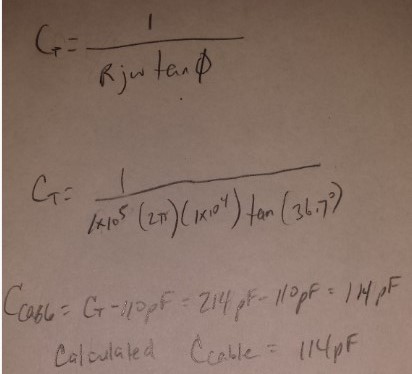| This is the scope reading of an Overcompensated probe | |
| This is the scope reading of an Undercompensated probe | |
| This is the scope reading of a Correctly Compensated probe |
Lab 2 - EE 420L
This is the scope reading of an Overcompensated probe This is the scope reading of an Undercompensated probe This is the scope reading of a Correctly Compensated probe
Capacitance of a 3-foot wire Experiment
The following is an experiment performed in order to determine the capacitance of a 3-foot wire by measuring the phase shift displayed on our scope.
| As we can see, the phase shift measured with our scope shows us a 36.7 degree shift. | |
 | When we measured the capacitance of the 3-foot wire, we received 131pF. This is close to our calculated Capacitance of 114pF. |
 | By wiring the 3-foot cable in parallel with our probe tip, and all in series with a 100kohm resistor, our total Capacitance is the sum of the 110pF of the probe, and the cable. |
Voltage Divider with 100Kohm Resistors
In this experiment, we show that uncompensated probes can significantly affect the measurement results of our circuit due to the loading effects of our measuring device. We accomplish this by building a voltage divider and measuring first with just a 3-foot cable and then with a compensated probe.
| The output voltage from the Uncompensated probe shows our pk-pk voltage at 38mV | The output voltage from the compensated probe shows our pk-pk voltage at 260mV. A much a higher reading from the uncompensated probing. |